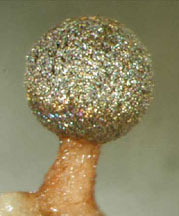Are you wondering why it is worth $125,000 to know what lives in the tops of trees? Click here to read about Melissa, who participated in a preceding grant of the tree canopy and who discovered a previously unknown myxomycete.! (Be sure to close that window when you are ready to come back to this screen.)
 |
|
What else might be living up in the treetops that we have never seen before? What changes are happening in the biosphere with humans taking up more and more space on earth and changing the chemistry of the air, soil, and water? What is the affect of global warming, pollution, invading species, and loss of habitat on organisms and their ecosystems? Questions like these inspire scientists to move beyond curiosity to posing testable hypotheses and conducting controlled experiments.
But before we can try to understand how humans are affecting the organisms of the world with so much change, we must know what organisms exist! Are you ready to be a part of this effort?
![]()
This tree canopy study seems overwhelmingly large, but it is only one small part of a much larger inventory of life in the Smokies called the All Taxa Biological Inventory (ATBI). The purpose of the ATBI is to answer three questions for every species of life in the GSMNP: 1. What is it? 2. Where is it? 3. What does it do? The ATBI supporters also are working to make this information easily accessible to a wide range of users by entering the information into a web-based database. Check it out by clicking on the preceeding "ATBI" link.

The GSMNP is said to have the greatest biodiversity of any location in North America and covers approximately 2,200 square kilometers (521,621 acres) in the southern Appalachian Mountains in the states of Tennessee and North Carolina. Elevation ranges from 270 m to 2,025 m and precipitation ranges from 165 cm/yr. At low elevations to over 250 cm/yr at the highest elevations. Ninety-five percent of the Park is forested, and although much of it has been disturbed, it still contains large tracts of virgin forest.
Thatís a lot of trees to climb and study! But your research team will only be able to sample a small percentage of the forest. How will you make sure that the results you obtain can be applied to the GSMNP in general? Planning, and lots of it, has already been done to make sure that this research study is a carefully controlled experiment. Are you ready to prepare for the trip?